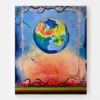
Those outside of the art world will think the work is finished when the final brushstroke has been made, the paint has dried or when the photographs have been printed. Those within it know different. The final part of creating a new body of work is to create an artist statement. This article is crucial to help the artist relay the message of their work – and it has many additional benefits. Learn what an artist statement really is, why they matter and how to create the best artist statements in this post.
What Is an Artist Statement?
Often an artist wants to complement their work by providing a written description of what they have created. This written statement is known as an artist statement – or an artist’s statement. You can think of this document somewhat like the recipe for their dish.
The overarching aim of the artist statement is to help onlookers understand the work or to justify it. It will often draw on the inspiration for the work, art theory and even art history, making connections between them.
By writing an artist statement, the work can be judged or interpreted in the way it has been intended by the artist. You can often find an artist statement on the wall of a new exhibition or within a handout at a gallery. This doesn’t necessarily stop the onlooker from making their own interpretation, but the artist’s is always readily available.
In recent years, the artist’s statement has been thought of as a piece of art in its own merit. This is a natural conclusion considering the written word has long been known to be a form of art in poetry, prose and so on.
There have even been exhibitions consisting of only artist statements, one of the most renowned was displayed in 2005 at the Hellenic Museum in Chicago, titled The Art of the Artist’s Statement.
Why an Artist Statement Matters
Artist statements matter for all of the reasons above. They bridge the gap between the artist and those viewing the art. But they can also be used for another important reason.
An artist statement can be sent with a body of work to a gallery or anyone who may want to pay to use the art. Ultimately, they can help artists sell their work, earn a place at an art school and make contacts within the art world.
So, How Do You Write a Good Artist Statement?
An artist statement should be like all good writing; it should be engaging, hold the reader’s attention and free from grammatical errors. In the case of the artist statement, it should be rather short, from a couple of hundred words to no more than a page long.
Many artists have difficulty in expressing their work in the written form because their talents lie elsewhere – with a paintbrush or camera in hand. The best way to cut through the noise and create an artist statement that gives the messages you want to make clear is by completing a few tasks first. These are:
#1: Make a Mind Map
Diving straight in could make you miss something that was influential in the process of creating your art. For that reason, it is beneficial to start off with a mind map. Use this map to consider all angles of your work and how it has been influenced, inspired and what it relates to.
#2: Explain Your work to a Child
What makes most writing bad is that it does not say what the writer intends. This is because we usually omit information that we think is obvious – but not always to the reader. It is why renowned professor Steven Pinker says to write well we must forget everything we have ever known about the subject.
Although that would be impossible, we usually do better when explaining our work to a child because we anticipate that they do not know things we normally would have expected an adult to know. Before you put pen to paper or fingerprint to keyboard, find your little brother, sister or niece and explain your artwork. Their follow-up questions may help you more than you anticipate.
#3: Self-Interviews
Imagine your body of work was receiving accolades and everyone wants to interview you. What would they be asking you about your work? Most questions are similar for all recognised artists, and you can easily find examples of artists being interviewed online.
Write these types of questions down and use them to interview yourself. They will help you position your thoughts and clarify why you did what you did.
#4: Be Authoritative
One of the biggest mistakes that leads to gallery owners to shake their heads is when the artist statement is indecisive rather than authoritative. You may not have the confidence to write “I did this..” and may opt for the safer “I was trying to…” – but you should always choose the former style.
New artists writing their first artist statement are more likely to not be confident to make bold statements. But they should also remember that standing by your work and ideas is admired within art circles.
Send Your Portfolio and Artist Statement to VZOW!
VZOW is a popular online marketplace selling art prints to art lovers. It is a place to showcase independent artist’s work whatever their experience and style. We sell your prints to homeowners and interior designers looking to add something unique to their walls.
Our site features many up-and-coming artists as well as some established names. If you want to show us your work, don’t be shy and send us your portfolio and an artist statement today.
For more information, contact our friendly team and don’t forget to browse through what our current artists have been creating!




